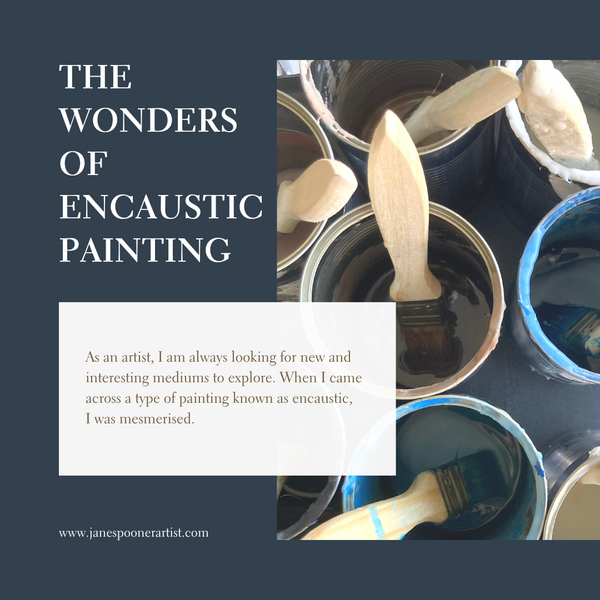
Wax is an excellent preservative for materials because it keeps them weatherproof. For example, the Greeks applied coatings of wax and pitch to their ships in order to keep them from deteriorating. They also began pigmenting the wax which led to the decoration of warships and merchant ships. By 500-323 BC, crude paint was being refined into something that could be applied with tar brushes onto panels--this established practice is known as encaustic painting.

Encaustic & Tempera
Furthermore, encaustic had much greater durability against moisture than tempera. In fact, Pliny references encaustic artworks several hundred years old that belonged to Roman aristocrats during his time.
Terracotta column-krater (bowl for mixing wine and water)
Encaustic & Sculpture
The white marble seen in Ancient Greece was once coloured, as evidence suggests they are either bold or delicate colours. However, there is little literary evidence of how this was done. It is most likely that the method of colouring varied depending on what part of Greece the statue was coming from. One example of such colouration can be seen in The Alexander Sarcophagus located in Istanbul's archaeological museum. Even though we cannot see how originally intense the colours were, it gives us a sense of what some statues may have looked like back then.
Encaustic or tempera paints were likely used on these vases, and they were "varnished" with fused wax. For example, a 4th-century BC terracotta krater is currently exhibited in the Metropolitan museum. It shows a painter using encaustic paint to colour a sculpture of Heracles while his servant uses metal spatulas that are being heated up by charcoal in a brazier.
 Mummy portrait of a man from Fayum. Encaustic on limewood, AD 80–100. Mummy portrait of a woman from Fayum, Hawara, modern-day Egypt. Encaustic on wood, AD 300–325. British Museum.
Mummy portrait of a man from Fayum. Encaustic on limewood, AD 80–100. Mummy portrait of a woman from Fayum, Hawara, modern-day Egypt. Encaustic on wood, AD 300–325. British Museum.
Fayum Portraits
The Fayum funeral portraits painted in the 1st and 2nd centuries A.D. by Greek painters in Egypt are some of the most well-known encaustic works. After Alexander conquered Egypt, a significant number of Greeks settled there and eventually began mummifying their dead. To memorialise these people, paintings were done either while they were alive or after they had passed away. These portraits would then be placed over the top of the mummy as a way to remember them.
Although it is a custom that many people are not aware of, funeral portraits were created starting after the conquest of Egypt by Rome. This trend only lasted for about two centuries before dying out. The reason these pieces have remained intact and with such fresh colouration is due to the converging influence of Egyptian religious ritual, Greek aesthetics and Roman fashions and social ranking during this time period.
The fall of the Roman Empire leads to mass economic instability, extinguishing the use of encaustic. Some forms including icon painting were carried out until as late as the 7th century, but it was mainly lost. Less demanding and cheaper alternatives such as tempera became more popular during this time.

Artworks by Jasper Johns, Lynda Benglis & Nancy Graves.
18th & 19th Century Revivals
Encaustic painting can be traced back to the 18th century when historians became intrigued by Pompeii and Herculaneum- two buried cities. They studied these areas extensively in an attempt to revive ancient painting methods. Furthermore, this type of painting was explored more in-depth during the 19th century as a way to solve the problem of mural paintings being ruined by moisture buildup in northern climates. Although it wasn't widely used, there were some amazing final products; John LaFarge's murals for Trinity Church in Boston are one example.
The portable electric heating implements invention in the early 20th century made encaustic a less challenging technique. Many artists were intrigued to try it out and make it their own. Robert Delaunay, Antoine Pevsner, Diego Rivera, Rifka Angel, Karl Zerbe, and Victor Brauner were among the first people to experiment with the revived technique.
Alfonso Ossorio, Jasper Johns, Lynda Benglis, Robert Morris, Nancy Graves, Mia Westerlund Roosen, and Robert Rauschenberg, are prominent among the many artists who turned encaustic into a modernist and cross-disciplinary medium, extending its use from painting to collage, assemblage, sculpture, and printmaking. In the 1940s, encaustic became available commercially. The latter part of the century saw a further explosion of encaustic painting propelled in part by the availability of commercial encaustic paint, first introduced by Torch Art Supplies in New York City in the late 1940s.
Conclusion
The history of encaustic painting is a long and varied one, with the technique experiencing periods of popularity and decline. What has remained consistent throughout this time, however, is the unique beauty that encaustic brings to artwork. The freshness of its colours and the versatility of its medium have continued to attract artists from all walks of life. In recent years, there has been a resurgence in interest in encaustic painting, with many new and innovative works being created using this ancient technique. We hope that this trend will continue well into the future, bringing more beautiful artworks into the world.
Join me in spreading the word! I'm sharing this inspiring article on Pinterest and invite you to do the same. Let's make sure everyone has access to great ideas, insights and knowledge - our way of helping each other grow! Click the below image and help share these ideas now – let’s make sure no one misses out! ↓

Reference list:
R&F . (Year Published). Title. History of Encaustic Available at: https://www.rfpaints.com/history-of-encaustic
Online Articles:
Gisela M.A. Richter. "Polychromy in Greek Sculpture." The Metropolitan Museum of Art Bulletin, supplement in April 1944 issue. Pliny the Elder, The Natural History: Book XXXV. An Account of Painting and Colours. Circa AD 77-79. Perseus Digital Library, Tufts University. "The Oldest Modernist Paintings" History and Archaeology, February 2012. Smithsonian.com "Proportion and Personality in the Fayum Portraits" The British Museum. Pliny the Elder, The Natural History: Book XXXV. An Account of Painting and Colours. Circa AD 77-79. Perseus Digital Library, Tufts University. Gail Stavitsky, Danielle Rice and Richard Frumess. Waxing Poetic: Encaustic Art in America During the Twentieth Century. Montclair Art Museum, May 1999. Edward M. Gomez. "ART / ARCHITECTURE; Improvised Images in Molten Wax, as Fluid as Jazz." New York Times 16 May 1999.


